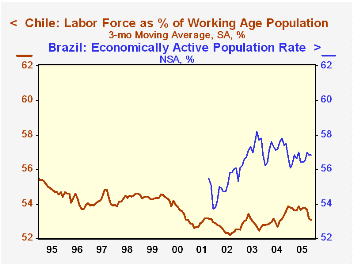 Global| Dec 29 2005
Global| Dec 29 2005Chilean Employment Down in November, but Yearly Growth Trend Maintained
Summary
The active sectors of the Chilean economy seem to have moderated a bit in the last couple of months, but are still keeping up favorable comparisons with a year ago. Total employment decreased 34,000 in November and 30,000 in October, [...]

The active sectors of the Chilean economy seem to have moderated a bit in the last couple of months, but are still keeping up favorable comparisons with a year ago. Total employment decreased 34,000 in November and 30,000 in October, but stands 1.7% ahead of November 2004, the same as the growth for 2004 as a whole. These data are reported as 3-month moving averages and seasonally adjusted by Haver Analytics. Within the National Statistics Bureau industry breakdown is a public service-type category "communal, social and personal services". If we subtract this group from the total, the remainder might be seen as a proxy for the overall private sector; it shows somewhat more slowing, with decreases for the last three months and only a 0.7% gain over the last year. The unemployment rate ticked higher in November, rising to 7.8% from 7.6% in October. However, this latter was the lowest figure since late 1998, as the world financial crisis was pushing it steeply higher, and it is down from a peak of 10.4% in late 1999.
One often thinks of mining when considering the Chilean economy, but mining and quarrying represents only 1.3% of its employment. Even so, this modest workforce generates about 7.3% of Chile's GDP. Otherwise, the mix of employment has, as in many other western countries, shifted over the last few years toward service industries, with growth in finance and transportation and communication, as well as the aforementioned "communal, social and personal services". Agriculture, while diminishing in recent years, still holds a sizable share of total jobs, about one in eight.
At the outset, we noted that these data refer to the "active" sectors of the Chilean economy; that distinction is notable, because there is a substantial "inactive" sector. Labor force participation is only about 53% of the population over age 15 and the employment/population ratio was just under 49% last month. These figures contrast with the US, where the labor force is 66% and employment 62.7% of the relevant population age range. Perhaps this is an unfair comparison and we should assess economic participation with Chile's neighbors: in Argentina, the urban population had a 45% participation rate in Q3 and a 40% employment rate and in Brazil, 56.8% and 51.3% for the relevant population segments. While the Brazilian numbers look favorable compared with Chile's, they refer to a sampling of metropolitan area populations which represent only about 22% of Brazil's total population of about 176,000,000. So from a broader perspective, Chile's population can be seen as the most economically active of these three major Latin American nations.
| Chile: 3-mo Moving Avg* | Nov 2005 | Oct 2005 | Sept 2005 | Nov 2004 | 2004 | 2003 | 2002 |
|---|---|---|---|---|---|---|---|
| Employment | 5.815 | 5.849 | 5.879 | 5.178 | 5.632 | 5.537 | 5.381 |
| Change (000) | -34 | -30 | +11 | 1.7% | 1.7% | 2.9% | 1.1% |
| "Private" Sector** | 4.151 | 4.173 | 4.205 | 4.121 | 4.069 | 4.024 | 3.903 |
| Change (000) | -23 | -32 | -3 | 0.7% | 1.1% | 3.1% | 1.9% |
| Unemployment Rate | 7.8 | 7.6 | 7.7 | 8.8 | 8.8 | 8.5 | 8.9 |
Carol Stone, CBE
AuthorMore in Author Profile »Carol Stone, CBE came to Haver Analytics in 2003 following more than 35 years as a financial market economist at major Wall Street financial institutions, most especially Merrill Lynch and Nomura Securities. She had broad experience in analysis and forecasting of flow-of-funds accounts, the federal budget and Federal Reserve operations. At Nomura Securities, among other duties, she developed various indicator forecasting tools and edited a daily global publication produced in London and New York for readers in Tokyo. At Haver Analytics, Carol was a member of the Research Department, aiding database managers with research and documentation efforts, as well as posting commentary on select economic reports. In addition, she conducted Ways-of-the-World, a blog on economic issues for an Episcopal-Church-affiliated website, The Geranium Farm. During her career, Carol served as an officer of the Money Marketeers and the Downtown Economists Club. She had a PhD from NYU's Stern School of Business. She lived in Brooklyn, New York, and had a weekend home on Long Island.





